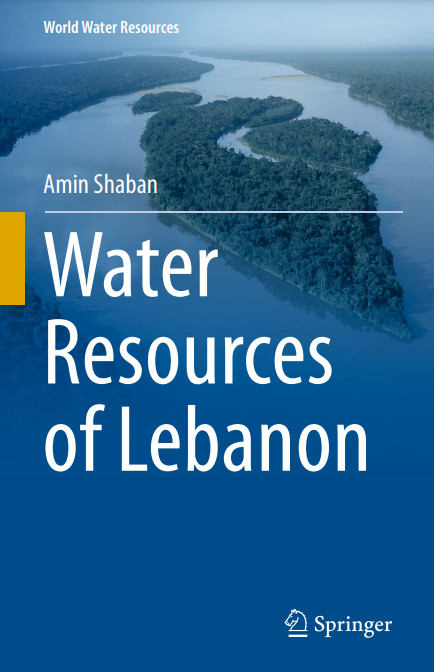Water Resources of Lebanon
 |
World Water Resources volume 7
livre , manuel Jan 2020 ; 237 pages
Aut. Amine Shaaban
Ed. CNRSL - Beirut
Téléchargeable sous format: PdF
Page de présentation d'un éditeur
Abstract:
This book describes all aspects of water resources in Lebanon, the surface and subsurface ones, with detailed discussion on new estimations. This book discusses all physical and anthropogenic factors that influence water resources. It also underpins comprehensive discussion on rivers, springs, snow, lakes, reservoirs, wetlands and groundwater. It, eventually, presents the existing challenges and proposes possible solutions to overcome them. Therefore, this book would be a helpful tool for different-level stakeholders, starting from individuals to high-level decision-makers. Contents:
1 Introduction . 1
1.1 Lebanon in the Regional View . 1
1.2 Historical Overview . 2
1.3 General Water Measurements . 4
1.4 Water Availability . 5
1.5 Water Demand . 5
1.6 Water Supply . 8
1.7 Previous Studies . 9
References . 10
2 Atmospheric Regime and Terrain Characteristics . 13
2.1 Atmospheric Variables . 13
2.1.1 Sources of Climatic Data . 15
2.1.2 Precipitation . 15
2.1.3 Temperature . 17
2.1.4 Evapotranspiration and Relative Humidity . 18
2.1.5 Aridity . 18
2.2 Morphology . 20
2.3 Karst Topography . 21
2.4 Geology . 24
2.4.1 Lithostratigraphy . 25
2.4.2 Structures Geology. 28
2.5 Land Cover/Use . 30
References . 32
3 Rivers . 35
3.1 Introduction . 35
3.1.1 Rivers Classification . 36
3.1.2 Rivers Description . 37
3.2 Drainages Systems . 40
3.2.1 Watersheds Extraction . 40
3.2.2 Watershed Classification . 42
3.2.3 Geometric Measurements . 43
3.2.4 Morphometric Measurements . 44
3.3 Quantitative Measures . 46
3.4 Transboundary Rivers . 49
3.4.1 El-Kabir Transboundary River . 49
3.4.2 Al-Assi Transboundary River . 49
3.4.3 Hasbani-Wazzani Transboundary River . 50
References . 51
4 Springs . 53
4.1 Introduction . 53
4.2 Springs Characteristics . 55
4.2.1 Types of Springs . 56
4.2.2 Springs Discharge . 61
4.3 Sub-marine Springs . 63
4.3.1 Concept of Identification . 64
4.3.2 Applied Methodologies . 65
4.3.3 Characteristics of Sub-marine Springs. 65
References . 70
5 Snow Cover . 73
5.1 Introduction . 73
5.2 Snow Cover Area . 75
5.2.1 Tools for Analysis . 75
5.2.2 Data Analysis . 77
5.3 Water Volume from Snow . 79
5.4 Physical Characteristics . 80
5.4.1 Snow Density (Sd) . 80
5.4.2 Snow Hardness (Sh) . 81
5.4.3 Snow Roughness (Sr) . 82
5.5 Influencing Factors . 82
5.6 Thickness-Altitude Relationship . 84
5.7 Melting Rate . 85
References . 87
6 Lakes and Reservoirs . 89
6.1 Introduction . 89
6.2 Lakes . 90
6.2.1 Type of Lakes in Lebanon . 91
6.2.2 Challenges on Lakes . 93
6.3 Reservoirs. 93
6.3.1 Dam Reservoirs . 94
6.3.2 Mountain Reservoirs . 99
6.3.3 Debate on Dams Construction . 100
References . 104
7 Wetlands . 107
7.1 Introduction . 107
7.1.1 Concepts . 108
7.1.2 Wetlands in RAMSAR Convention . 109
7.2 Wetlands in Lebanon . 111
7.2.1 Wetlands Description . 111
7.2.2 Wetlands Degradation . 113
7.2.3 Criteria to Characterize Wetlands in Lebanon . 115
References . 123
8 Groundwater . 125
8.1 Introduction . 125
8.2 Hydrogeological Characteristics . 127
8.2.1 Aquiferous Properties . 127
8.2.2 Hydraulic Properties . 131
8.3 Estimated Aquifers’ Capacity . 132
8.4 Groundwater Recharge . 136
8.4.1 Factors Controlling Recharge Rate . 137
8.4.2 Data Manipulation . 140
8.5 Groundwater and Faults . 142
8.5.1 Elements of Investigation . 142
8.5.2 Data Analysis . 143
8.6 Groundwater Level and Discharge . 148
8.6.1 Groundwater Level . 148
8.6.2 Groundwater Discharge . 153
8.7 Groundwater Wells . 154
8.7.1 Public Wells . 154
8.7.2 Private Wells . 154
8.7.3 Drilling Wells . 155
References . 157
9 Challenges on Water Resources . 161
9.1 Concepts . 161
9.2 Method of Analysis . 163
9.2.1 Data Preparation. 164
9.2.2 Data Analysis . 166
9.3 Natural Challenges . 167
9.3.1 Topography and Geology . 168
9.3.2 Meteorological Conditions. 169
9.3.3 Hydrological Elements. 171
9.3.4 Trans-Boundary Water . 177
9.4 Man-Mad Challenges . 177
9.4.1 Population Growth . 178
9.4.2 Quality Deterioration . 179
9.4.3 Unwise Use of Water Resources . 180
References . 181
10 Proposed Solutions . 185
10.1 Dimensions of Water Crisis . 185
10.1.1 Spatial Dimensions. 186
10.1.2 Temporal Dimensions . 190
10.1.3 Future Expectations . 190
10.2 Proposed Solutions on Surface Water . 192
10.2.1 Mountain Reservoirs . 192
10.2.2 Dam Reservoirs . 194
10.2.3 Water-Convey Canals . 196
10.2.4 Rooftop Rainwater Harvesting . 196
10.2.5 Snowpack Reservation . 197
10.3 Proposed Solutions on Groundwater . 198
10.3.1 Artificial Groundwater Recharge . 198
10.3.2 Capturing Groundwater Discharge into the Sea . 204
10.4 Mitigation of Water Pollution . 208
10.5 Economic Policies . 209
10.6 Ethics and Water . 213
10.6.1 Aspects of Bad Ethics in Water . 214
10.6.2 Changing Ethics in Water . 215
10.7 Lebanon in SDG . 216
References . 218
Index . 221
Publics-Cibles:
Mots clefs: |
accès à l'eau (CI) (DT) (OP) (ope) , eau (CI) (DT) (OP) (ope) , eau non potable (réseau d') (CI) (DT) (OP) (ope) , eau potable (CI) (DT) (OP) (ope) , gestion de la ressource en eau (CI) (DT) (OP) (ope) |
Pays concerné: |
Editeur/Diffuseur: |
|
CNRSL
-
Conseil national de la recherche scientifique du Liban - Beirut - Liban |
En cas de lien brisé, nous le mentionner à communication@pseau.org